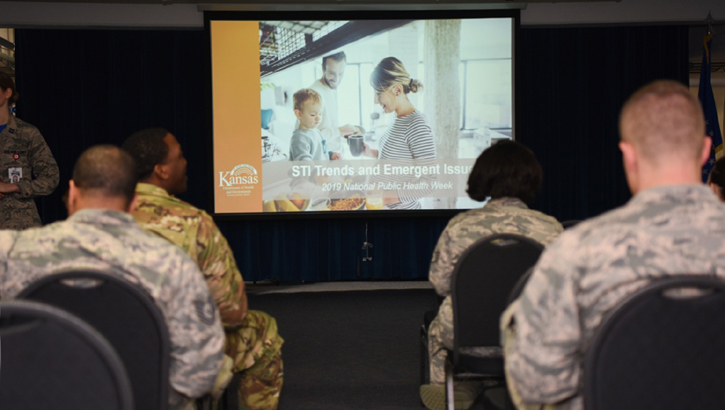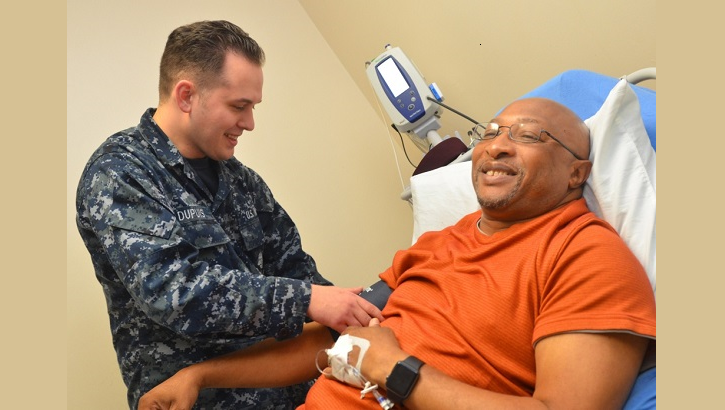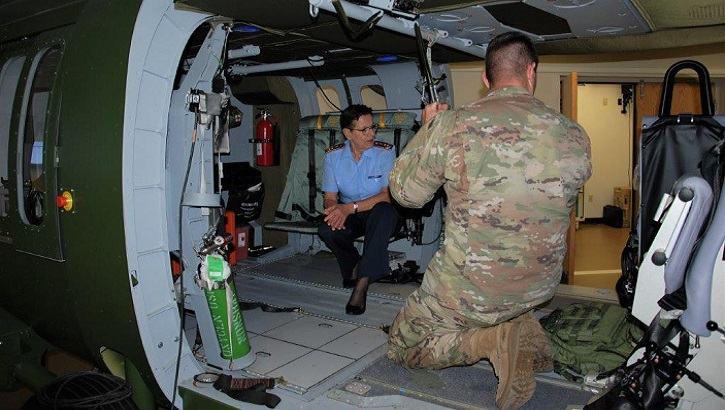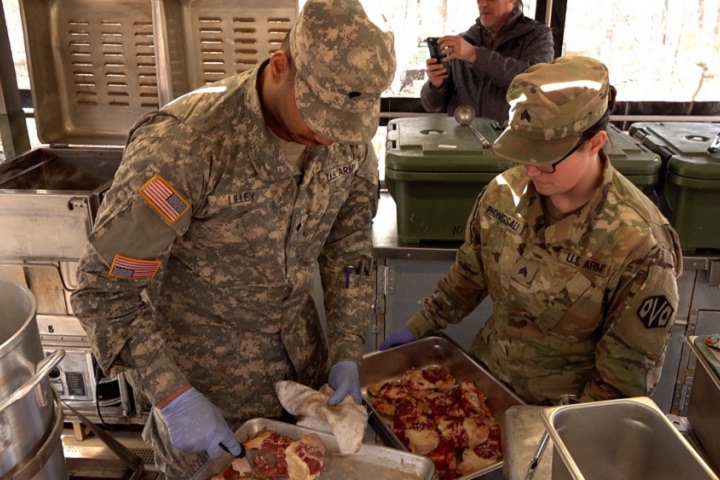
Sexually transmitted infections on the rise in military

Some sexually transmitted infections are on the rise in the military. To increase awareness, members of Team McConnell attend a briefing on STIs at McConnell Air Force Base, Kansas. (U.S. Air Force photo by Airman 1st Class Alexi Myrick)
The rates of certain types of sexually transmitted infections, or STIs, are rising dramatically for both male and female service members, according to a recent report. These STIs include chlamydia, gonorrhea, and syphilis. Data from the Centers for Disease Control and Prevention confirm similar surges for these three types of infections in the civilian population. The current high rates in the military pose challenges for more than 1.3 million DoD personnel, 84 percent of whom are men.
“We have a large number of males in the service, and the population we see normally is the 18 to 25 year olds. STI is most common in that age group,” said Norma Jean Suarez, a nurse practitioner in preventive medicine at Brook Army Medical Center in San Antonio. She added that the men she sees often don’t know how prevalent STIs are.

STI myths (MHS graphic)
“STIs place a significant economic strain on the U.S. and military health care systems,” said Maj. Dianne Frankel, an Air Force internal medicine physician and USU preventive medicine resident. In 2012, STIs in the Navy alone accounted for health care costs of $5.4 million.
“From a military standpoint, STIs can have a significant impact on individual readiness, which in turn impacts unit readiness, which then leads to a decrease in force health protection,” said Frankel. She added that there can be serious health consequences for untreated STIs, including, down the road, cancer in the case of genital human papillomavirus, or HPV.
But why are STIs on the rise, and why now? “There appears to be an increase in high-risk behaviors among service members; that is, having sex without a condom or having more than one sexual partner,” said Frankel, referring to the 2015 DoD Health-Related Behaviors Survey, known as HRBS. This report documented that one-fifth of respondents reported having more than one sexual partner in the past year, while one-third reported having sex with a new partner in the past year without use of a condom. These numbers have doubled since the last reported survey in 2011, said Frankel.
Suarez added another factor she’s been seeing: Dating apps can promote random, anonymous encounters, and when infections result, that anonymity can make partners difficult to track down. Having anonymous sex is one of the CDC’s list of behaviors that can increase risk of contracting an STI or HIV. Others include having vaginal, oral, or anal sex without a condom; having multiple sexual partners; or having sex while under the influence of drugs or alcohol, which can lower inhibitions and result in greater sexual risk-taking.
In general, STIs spread readily if precautions aren’t taken, according to Col. Amy Costello, chief of preventive medicine at the Air Force Medical Support Agency. “Chlamydia and gonorrhea are quite common; they can be transmitted vaginally, anally, or through oral-sexual contact,” she said. “Pretty much any time you have mucous membrane contact with an infected person, you have a chance of getting it.” She added that syphilis is usually spread through open sores that can be non-painful, meaning an infected person might not know the infection is present.
Not all STIs are on the rise, according to the HRBS. Rates for genital herpes simplex decreased slightly between 2010 and 2018, and HPV dropped by almost 52 percent. She credited the widespread adoption of the HPV vaccine for the dramatic decline in the rate of infection.
HIV is another STI of concern. “A lot of service members don’t understand that HIV exists on the active-duty military side,” said Suarez. “Here in San Antonio alone, we manage 30+ HIV-positive active-duty soldiers.” But rates of HIV are much lower in the military than in the U.S. population, Frankel said, adding that numbers for HIV from 2012 – 2017 “have been relatively stable.”
Costello said that chlamydia, gonorrhea, and syphilis are bacterial infections that are treated with antibiotics. HPV, herpes, and HIV are viruses and more difficult to treat. She said the most reliable way to avoid getting an STI is to stay away from oral, vaginal, and anal sex unless in a long-term, mutually monogamous relationship with a partner known to be uninfected. But, she added, “That’s not a realistic plan for many of our younger service members who aren’t yet married or in long-term monogamous relationships.” Therefore, condom use is critical, she concluded, and any symptoms should lead to testing.
Efforts are ongoing to combat the rise of STIs through education. “STIs are preventable,” said Frankel. “It’s important for everyone to know how to protect themselves and their partners.”
2019 Men's Health Case Studies
Publication
6/27/2019
This chart summarizes case studies of adult male patients in different life stages
Men’s preventive health screenings essential for readiness and a lifetime of good health
Article
6/27/2019

An apple a day helps, too
Mail-in colon cancer screening may end colonoscopy for most
Article
6/19/2019

The best test is the one the patient will do
Experts: Carbs are not the enemy in health, wellness battle
Article
6/18/2019

Shift focus away from any specific macronutrient, experts say
German allies visit JBSA-Fort Sam Houston on 75th anniversary of D-Day
Article
6/14/2019

The purpose of this visit was to further strengthen the bonds and interoperability programs between our allied countries or partner nations
Nine tips for Men's Health
Article
6/12/2019

Many major health risks can be prevented by lifestyle choices
Take Command of your health during Men’s Health Month
Article
6/6/2019

Men’s Health Month is a great time to focus on taking preventive steps and making small changes to your lifestyle
A healthy lifestyle is integral to achieving my career goals
Article
6/4/2019

Men's Health Month reminds me to go beyond box-checking
Cyclosporiasis
Infographic
6/1/2019

Outbreak of Cyclosporiasis in a U.S. Air Force Training Population, Joint Base San Antonio–Lackland, TX, 2018 While bacteria and viruses are the usual causes of gastrointestinal disease outbreaks, 2 Joint Base San Antonio (JBSA)– Lackland, TX, training populations experienced an outbreak of diarrheal illness caused by the parasite Cyclospora cayetanensis in June and July 2018. Cases were identified from outpatient medical records and responses to patient questionnaires.
Female infertility
Infographic
6/1/2019

Female infertility, active component service women, U.S. Armed Forces, 2013–2018 This report presents the incidence and prevalence of diagnosed female infertility among active component service women. During 2013–2018, 8,744 active component women of childbearing potential were diagnosed with infertility for the first time, resulting in an overall incidence of 79.3 cases per 10,000 person-years (p-yrs).
Norovirus
Infographic
6/1/2019

Norovirus Outbreak in Army Service Members, Camp Arifjan, Kuwait, May 2018 In May 2018, an outbreak of gastrointestinal illnesses due to norovirus occurred at Camp Arifjan, Kuwait. The outbreak lasted 14 days, and a total of 91 cases, of which 8 were laboratory confirmed and 83 were suspected, were identified.
MSMR Vol. 26 No. 6 - June 2019
Report
6/1/2019
A monthly publication of the Armed Forces Health Surveillance Branch. This issue of the peer-reviewed journal contains the following articles: Modeling Lyme disease host animal habitat suitability, West Point, New York; Incidence, timing, and seasonal patterns of heat illnesses during U.S. Army basic combat training, 2014–2018; Update: Heat illness, active component, U.S. Armed Forces, 2018; Update: Exertional rhabdomyolysis, active component, U.S. Armed Forces, 2014–2018; Update: Exertional hyponatremia, active component, U.S. Armed Forces, 2003–2018
DHA PI 6200.02: Comprehensive Contraceptive Counseling and Access to the Full Range of Methods of Contraception
Policy
This Defense Health Agency-Procedural Instruction (DHA-PI), based on the authority of References (a) and (b), in accordance with the requirements of References (c) through (i), and the guidance of References (j) through (v), establishes the Defense Health Agency’s (DHA) procedures for comprehensive standards on healthcare with respect to access to comprehensive contraceptive counseling and the full range of contraceptive methods for members of the Armed Forces and all eligible beneficiaries of the Military Health System (MHS).
- Identification #: 6200.02
- Date: 5/13/2019
- Type: DHA Procedural Instruction
- Topics: Women's Health
Mother's Day a chance to highlight care in the Military Health System
Article
5/8/2019

The Military Health System helps deliver more than 100,000 babies each year
Preventive Medicine techs foil the foe
Article
5/6/2019

The adversary can impact Sailors and Marines everywhere






















.png)











No hay comentarios:
Publicar un comentario